Integrating AI and keeping tech debt under control are top concerns for most companies invested in software development this year. Since Python is the leading choice for AI and machine learning, it’s no surprise that it tops both the TIOBE index and global search volumes.
As a custom software development company that builds digital products from the ground up, we’ve worked extensively with Python. That’s why we created this guide: to give you a clear, actionable overview of the role of this open-source programming language in modern software development. We’ll review its strengths, limitations, and business use cases.
Let’s dive into what Python is and why it might be the right fit for your next project.
What is Python?
A textbook might define Python as an interpreted, high-level, dynamically typed, object-oriented programming language. But what does this actually mean for your business?
- Interpreted: Python doesn’t require a separate compilation step. Developers can test and iterate on code in real time, accelerating development and reducing time-to-market.
- High-level and dynamically typed: Python handles much of the complexity behind the scenes. Developers can focus on solving business problems instead of managing low-level details or strict type declarations, which is especially valuable for prototyping and MVPs.
- Object-oriented: Python allows developers to extend and adapt software without rewriting large portions of code. This quality makes it ideal for growing, modular platforms that evolve over time.
- Readable and maintainable: Python emphasizes readable syntax and clear structure. This makes the codebase easier to understand and maintain, which shortens onboarding time for new developers and reduces long-term technical debt.
- Versatile: From web platforms and automation tools to AI-driven systems and data pipelines, Python adapts to a wide range of business applications.
In short, software development with Python offers the clarity, flexibility, and vast ecosystem support to keep your project agile and scalable, from concept to production.
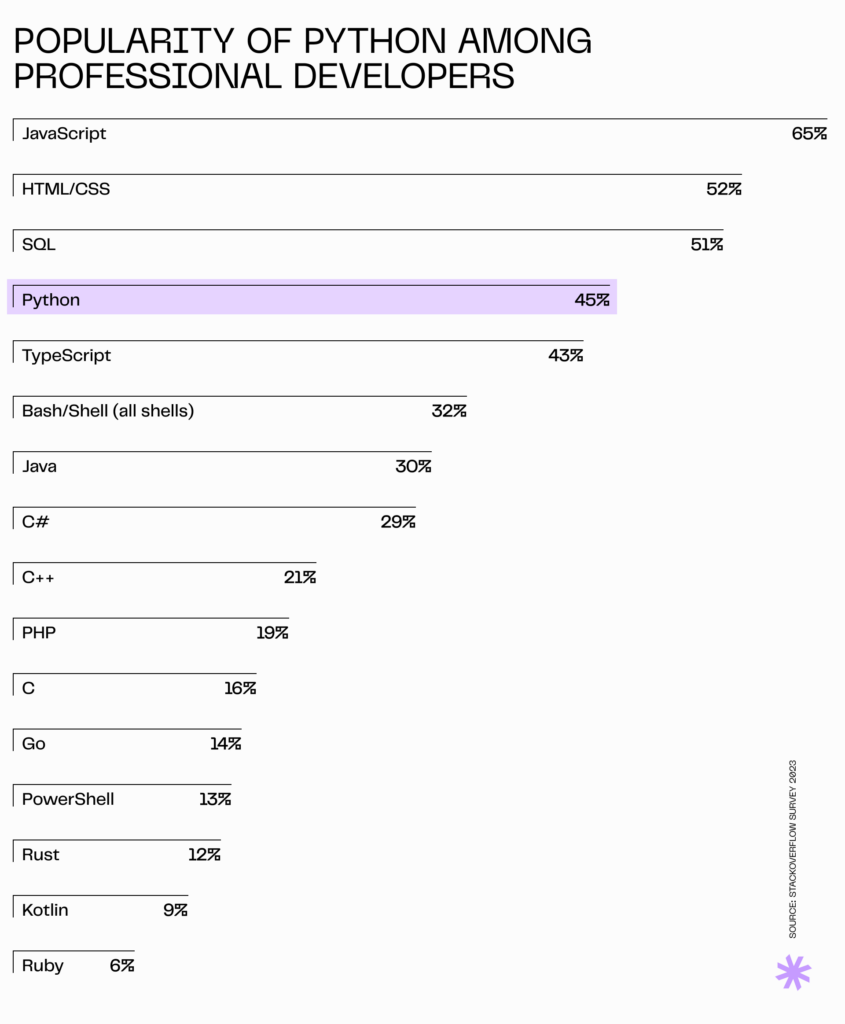
How much could Python boost your ROI?
Let’s talk about your project and uncover the opportunities.
Book a free consultationWhat can Python programming be used for
Python is an amazingly versatile programming language well-suited for building a wide variety of digital products. Here are some of the most common business applications of Python:
Web development
Python excels in backend development thanks to powerful web frameworks like Django, Flask, and FastAPI. These accelerate time to market and ensure scalability and are especially effective for creating admin panels, APIs, and internal tools that support mobile frontends or browser-based applications.
Business applications
For CRM, ERP, or billing systems, Python provides the reliability, maintainability, and integration flexibility that enterprise-grade software requires. Its clean syntax and strong third-party libraries reduce web development overhead while making it easier to evolve systems over time.
Data-driven software
Python is also widely used to power everything from BI dashboards to ETL pipelines. With Python libraries like Pandas, NumPy, and Plotly, it simplifies complex data processing and data visualization, enabling teams to extract insights and act on them more effectively.
AI & machine learning applications
When it comes to AI and machine learning, Python is the undisputed leader. Frameworks like TensorFlow, PyTorch, and Scikit-learn offer a mature, production-ready foundation for predictive models, recommendation systems, NLP solutions, and computer vision tools.
Its popularity here stems from its simplicity, vast community, and seamless integration with modern tech stacks.
Automation & scripting
Python truly shines in automation, from eliminating repetitive tasks with lightweight scripts to orchestrating complex workflows across APIs and platforms.
Cloud computing
Python integrates seamlessly with major cloud platforms like AWS, Google Cloud, and Azure, making it an excellent choice for cloud-native development. It’s widely used for building scalable APIs, serverless applications, and automation tools within cloud environments, as well as for managing infrastructure through tools like Ansible, Terraform, and Boto3.
MVPs & prototypes
Python software development is also a strong choice for startups and innovation teams building MVPs or prototypes. Its speed, flexibility, and low barrier to entry help reduce costs and bring ideas to life faster.
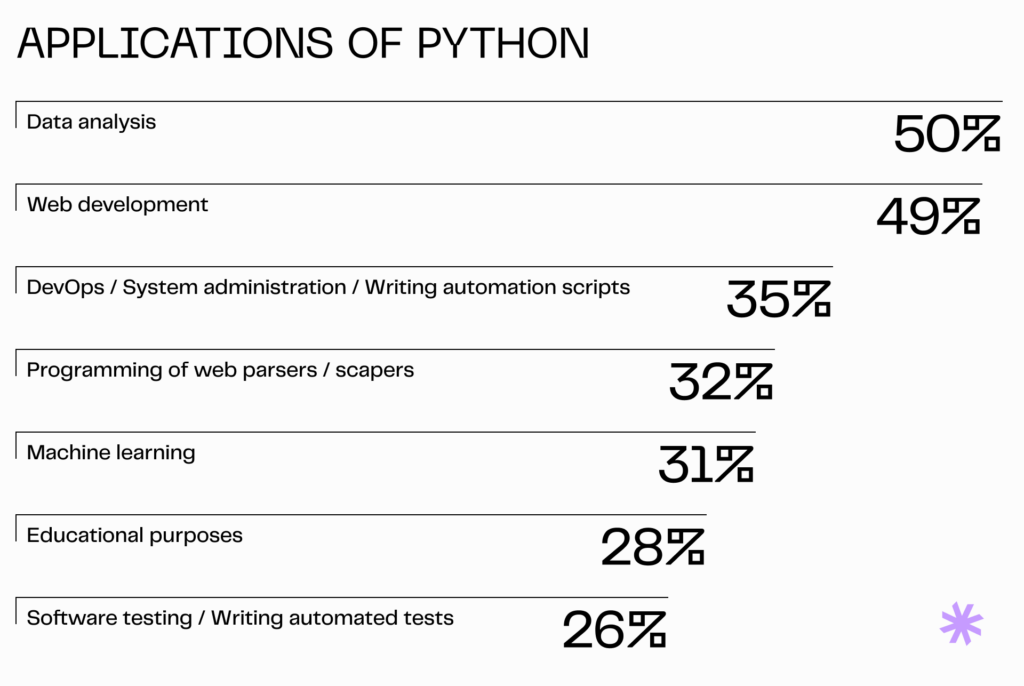
Why choose Python to build software?
Python isn’t popular for nothing, it’s purposefully designed to make software development faster, safer, and more adaptable. Here’s why businesses often choose it as their go-to technology:
Simple syntax
Python’s code structure is close to plain English, making it easy to understand, even if you didn’t write it yourself. It’s also less verbose than many other programming languages, so Python developers can express ideas in fewer lines of code.
Compare:
Python:
def greet(name):
return f"Hello, {name}!"JavaScript:
function greet(name) {
return "Hello, " + name + "!";
}Python also supports dynamic typing, meaning you don’t need to declare the type of data a variable will hold. The language figures it out at runtime. This flexibility speeds up development and makes it easier to adapt code as requirements evolve, especially compared to statically typed languages.
Pre-built tools
Python includes a large standard library of built-in modules for common tasks, from file handling and math to data manipulation and internet protocols. Software developers can build faster without relying on third-party modules for everyday needs.
These features enable teams to move quickly from concept to implementation, supporting faster development cycles, earlier testing, and quicker time to market.
Informative error messages
When something goes wrong, Python provides detailed tracebacks that show:
- The type of error (e.g., TypeError, ValueError)
- The exact line number where it occurred
- A snippet of the code that caused the issue
This helps Python developers quickly locate and understand the problem, saving the time spent on debugging and reducing the risk of missing a critical bug.
Strong community and extensive support
Python’s active global community continuously improves the language, responds to issues quickly, and maintains extensive documentation. For businesses, this means:
- Faster problem-solving as most challenges already have solutions online;
- Reliable tools and libraries with reusable components that are actively maintained and trusted;
- Easier hiring and onboarding as skilled Python developers are relatively easy to find thanks to the popularity of the programming language.
Altogether, these factors make Python a safe, future-proof choice for long-term projects.
Excellent fit for AI, data, and automation
Python dominates AI and data science thanks to its simplicity and specialized libraries like PyTorch, Scikit-learn, and NumPy. It also plays well with APIs, databases, and other programming languages, making it ideal for automation tasks that involve integrating different tools and data sources.
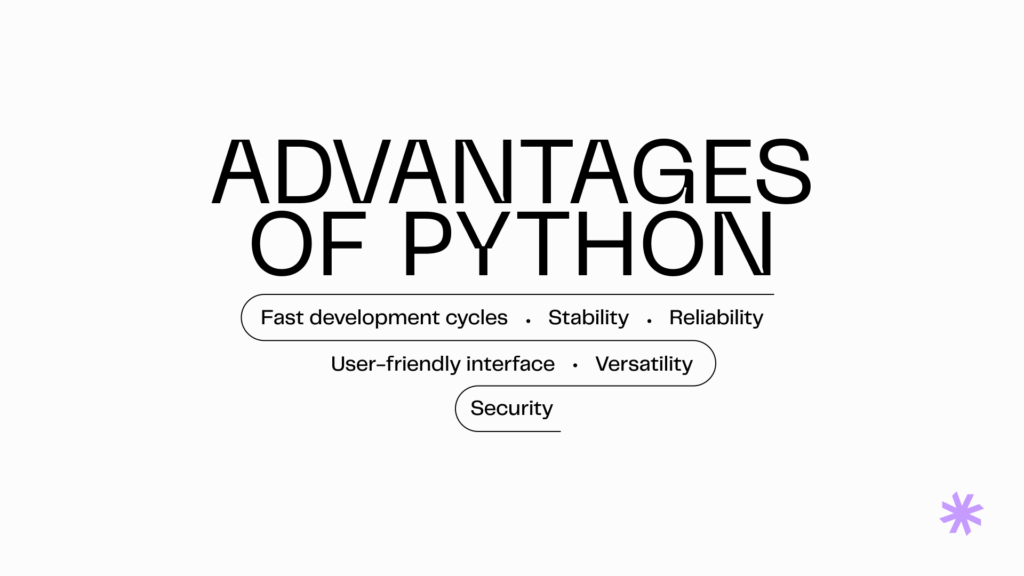
Curious how Python could speed up your product launch?
Let’s talk about how Syndicode can help you make the most of it. Book a call today
Book a callLimitations of Python as a programming language
While Python is a powerful language, it has limitations that may impact certain types of projects. Here are the key disadvantages, and when another technology might be a better fit:
Slow execution speed
Python is an interpreted language, which adds overhead at runtime. This makes it less suitable for performance-critical applications such as high-frequency trading platforms, video games, or simulations that require intense numerical computation.
In these cases, developers typically opt for low-level, compiled languages like C, C++, or Rust that offer greater control over performance.
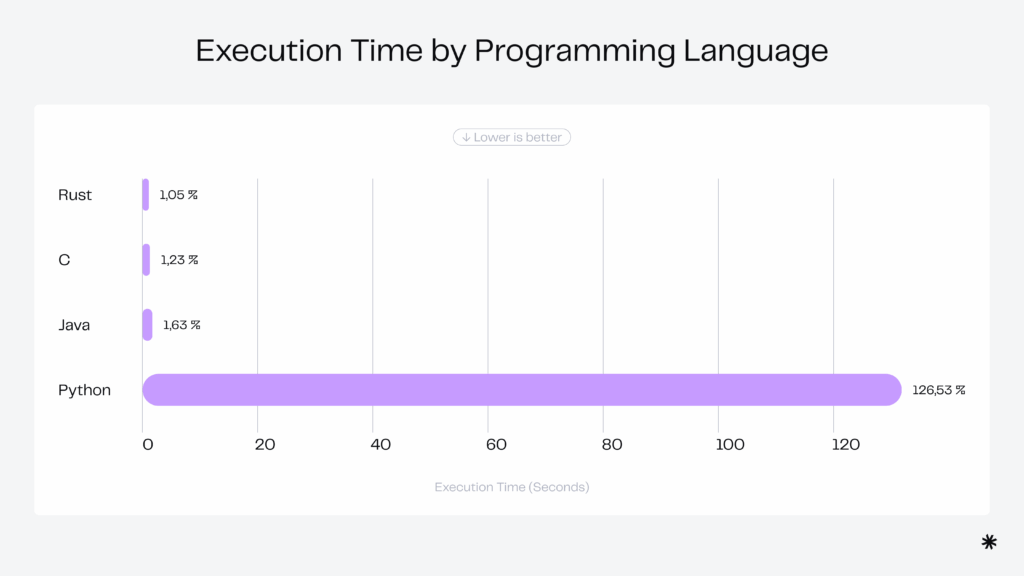
High memory consumption
Due to its dynamic nature and higher-level data structures, Python tends to consume more memory than lower-level languages. This can be a concern when creating applications running on memory-constrained devices (like mobile phones, IoT hardware) or those that process large volumes of data in real time.
Better-suited alternatives include:
- C or C++ for fine-grained memory control
- Go for large-scale data processing
- Kotlin or Swift for native mobile development
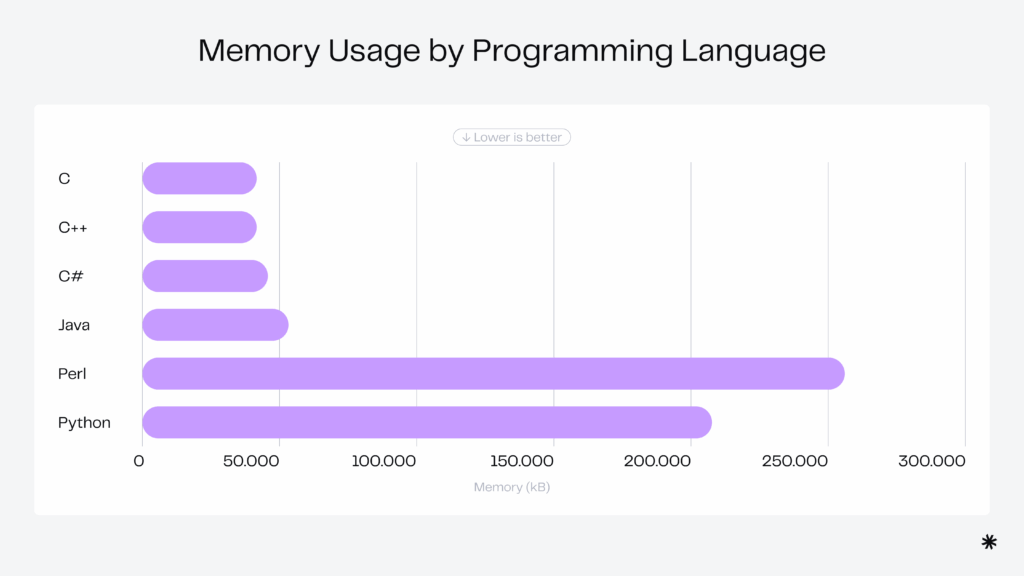
Runtime errors
Python’s dynamic typing allows rapid development but increases the risk of bugs that only show up during execution. In large or mission-critical applications, this can raise the cost of quality assurance and lead to hard-to-detect issues.
Programming languages with static typing, such as Java, C# (.NET), or Rust, provide better type safety and early error detection during compilation, which is especially valuable in regulated or high-risk environments.
Limited multithreading support
Python’s Global Interpreter Lock (GIL) limits true parallelism in multi-threaded applications. This makes it undesirable for software development projects requiring high concurrency, like messaging platforms, real-time analytics engines, or chat-based infrastructure.
Alternatives like Go (with goroutines) and Erlang (built for concurrent processing) are more efficient choices for these architectures.
Dependency on third-party packages
Although Python’s ecosystem is a major strength, it often relies on third-party packages for core functionality. These packages can vary in quality, support, and long-term maintenance, introducing risks for projects that demand high stability or strict compliance.
For software development that requires long-term stability, enterprise-grade tooling, or vendor-level support, platforms like Java (Oracle-supported) or .NET (Microsoft) offer more standardized solutions with predictable support lifecycles.
However, if vendor lock-in is a concern and development speed and flexibility are a priority, Ruby on Rails is a strong choice, as long as the project doesn’t depend on AI or automation. Rails minimizes architecture decisions and comes with many features out of the box, enabling teams to focus on delivering product value faster.
Read also: How to choose the right tech stack for your project?
Popular Python frameworks & libraries and what they’re used for
Python’s rich ecosystem is one of the main reasons businesses choose it for software development. It offers mature, flexible frameworks and libraries across multiple domains, from building scalable web applications to powering AI features and automating repetitive tasks. This reduces time-to-market, lowers development risks, and ensures your product is built on proven, stable foundations.
Here’s a breakdown of the most widely used tools and what they’re good for.
Web development frameworks
Python offers both lightweight and full-stack web development frameworks for building everything from robust platforms to quick APIs across all operating systems.
Django
A full-stack framework that includes built-in tools for database management, security, admin interfaces, and templating. Ideal for fast, secure development of complex web applications that require long-term scalability.
Flask
A microframework that gives developers more flexibility. It’s often used for APIs, small-to-medium web apps, or services that don’t need a heavy backend structure. A great choice for MVPs or modular architecture.
FastAPI
Built for high-performance APIs, especially in data-driven or AI-related products. It’s modern, fast, and works well for real-time applications and integrations.
Note: If your project is a content-heavy web platform or marketplace and developer velocity is a top concern, Ruby on Rails development or Node.js programming may be faster to get started with. Still, Python remains stronger for projects that require AI, automation, or complex integrations.
Machine learning & AI libraries
Python dominates in AI/ML thanks to its powerful, production-ready tools:
- TensorFlow, PyTorch are used to train and deploy advanced models
- Scikit-learn is great for traditional machine learning and predictive analytics
- Keras, XGBoost are ideal for building fast prototypes and boosting performance
These tools power everything from recommendation engines to predictive maintenance systems
Data science & analytics libraries
Python simplifies complex data tasks and supports visual storytelling through:
- Pandas, NumPy are used for data transformation and number crunching
- Matplotlib, Seaborn, Plotly good for interactive charts, dashboards, and visual insights
These are perfect for business intelligence platforms or any product that turns raw data into actionable decisions.
Automation & scripting tools
Python is a top choice for automating workflows, integrating with APIs, and removing manual processes. Common tools include:
- Requests, BeautifulSoup are used for web scraping and data extraction
- Selenium helps with automating browser-based tasks
- PyAutoGUI, Click serve for UI automation and command-line tools
These are especially useful in internal tools, RPA, and custom integrations.
DevOps & testing frameworks
Python’s developer tooling makes it easy to maintain code quality and streamline deployments:
- pytest, unittest, tox – for robust, automated testing
- Ansible, Fabric, Invoke – for deployment scripts and infrastructure automation
These tools help ensure your product remains stable, testable, and easy to deploy at scale.
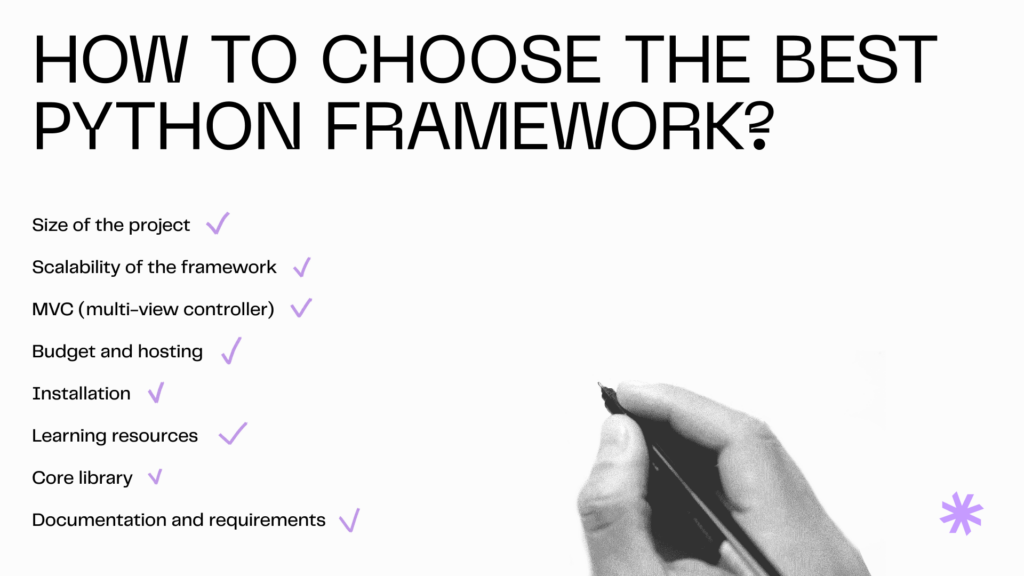
Not sure if Python is the right fit for your product?
Let’s discuss your goals, constraints, and tech vision. Send us a message and we’ll help you weigh the options and build a plan that works.
Write to usHow to build software using Python?
We’ve already shared a detailed guide to custom software development. Below is a condensed, Python-specific version of a general development process to help you evaluate Python as the foundation for your product:
1. Discovery & requirements gathering
The discovery stage involves defining the business goals, technical requirements, and user needs. It may include workshops, competitor analysis, and stakeholder interviews. The goal is to align the software vision with measurable outcomes.
Python’s flexibility is especially useful here as it enables rapid prototyping, allowing you to test assumptions and iterate quickly before investing in full-scale development.
2. Architecture planning & technology selection
The development team decides on the system architecture, infrastructure setup, and the most suitable Python stack for your goals:
- Django for full-stack web platforms with built-in admin and security features
- FastAPI for lightweight, high-performance APIs
- Async frameworks for real-time apps or integrations
- Data science and automation tools, when relevant
In parallel, we start working on documentation. At this stage, QA specialists step in to help design the system architecture to ensure it supports long-term scalability and security.
Read also: The difference between testing and QA
3. Prototyping or MVP development (optional)
We at Syndicode often start with a prototype or Minimum Viable Product (MVP) to validate assumptions, test functionality, and gather early feedback. This is especially important for integrating new features with a legacy system or non-standard solutions.
Read also: How to build an MVP?
4. Frontend & backend development
The web developers build the backend logic, integrates databases, and develops APIs. Frontend development (in frameworks like React or Vue) happens in parallel, ensuring the product is both functional and user-friendly.
5. Testing
Automated and manual testing are done to catch bugs early and ensure performance, security, and usability. Python’s rich testing ecosystem helps maintain high code quality from the start.
Read also: What is the software testing lifecycle?
6. Deployment & monitoring
Once stable, the product is deployed to a live environment, often using cloud platforms like AWS or Azure. Python’s DevOps ecosystem makes it easy to automate deployments, monitor system health, and scale across environments.
Python-based projects are often deployed using:
- Docker for containerization
- Kubernetes or cloud services (e.g., AWS, Azure) for scalability
- Fabric or Ansible for automated deployment.
7. Maintenance & continuous improvement
After launch, the team monitors user feedback and system performance to plan updates, fix issues, and roll out new features. As for maintenance, we offer:
- Corrective maintenance (bug fixes)
- Preventive checks to avoid downtime
- Perfective upgrades (new features, optimizations)
- Adaptive changes (e.g., compliance updates or third-party API changes)
These activities ensure long-term value and adaptability of the solution as business needs evolve.
Real-life examples of Python software
Over the years, Python has become a leading language in data science, machine learning, and artificial intelligence, including advanced areas like natural language processing and predictive analytics. It’s even used in game development and desktop applications, proving its versatility across domains.
Below are some of the most well-known examples of the Python programming language in action.
The social media giant uses Python to handle the massive volume of data flowing through its backend. Python’s scalability and development speed help Instagram quickly test and introduce new features, and operate smoothly at a global scale.
YouTube
YouTube relies on Python for managing video content and backend processes. Python’s versatility and extensive library are crucial for serving billions of users while ensuring performance and uptime.
Dropbox
Dropbox adopted Python early for both its server-side logic and desktop application. Python’s cross-platform capabilities and maintainable codebase make it a great fit for fast growth and seamless user experience across devices.
Spotify
Spotify uses Python extensively for backend services, data analysis, and personalization algorithms. Its ability to process large volumes of data quickly is key to Spotify’s recommendation engine and real-time analytics.
Reddit was originally written in Lisp, but migrated to Python for backend web development to take advantage of its readability and developer productivity. Python’s clean syntax allows Reddit to maintain and scale its platform efficiently as the community grows.
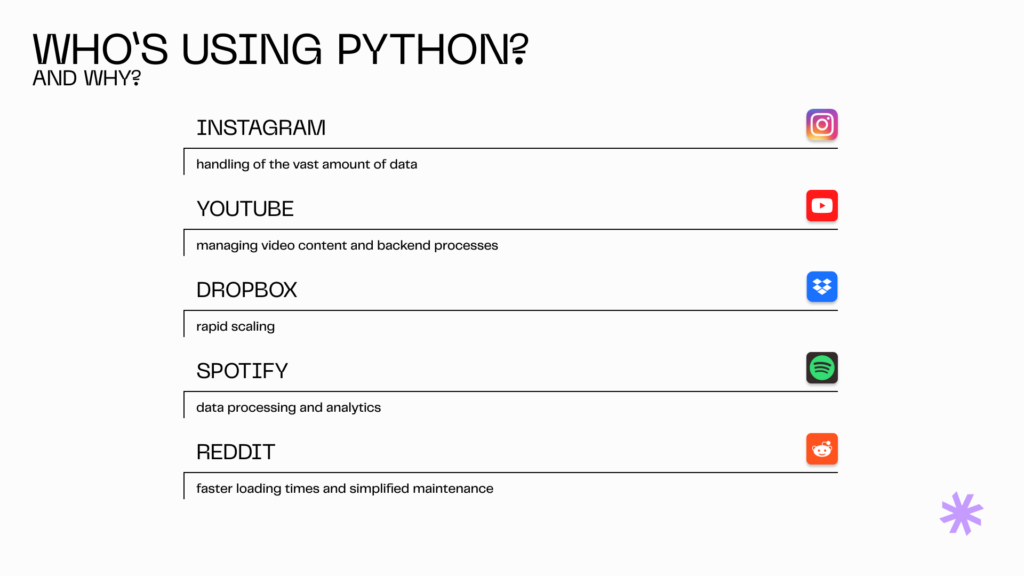
Have a software idea but unsure how to build it?
Whether you’re starting from scratch or modernizing a legacy system, our experts will help you assess the best architecture, tools, and roadmap for your product. Book a free consultation and get tailored guidance from Syndicode’s Python team.
Contact usHow Syndicode can help with Python development
Syndicode is ready to support you with full-cycle, end-to-end services: from business analysis and design to development, testing, deployment, and post-launch support. We’ve been delivering custom software solutions for over a decade, helping startups and established companies turn complex ideas into scalable, user-friendly digital products.
Our Python developers for hire are highly skilled in all major frameworks, including Django, FastAPI, and Flask. They follow established best practices to ensure performance, maintainability, and long-term success. Just as importantly, we foster a problem-solving mindset, prioritize clear communication, and encourage continuous professional growth across our team. We don’t just keep up with new technologies, we actively seek to master them.
We’re also working hard toward becoming a trusted AI development partner, expanding our capabilities in machine learning, data engineering, and intelligent automation. One example is Maxwell, a platform we developed in collaboration with a leading construction company to visualize, manage, and present prefabricated building solutions. Powered by a Python backend, Maxwell brings together structured data, automation, and dynamic content generation. It not only streamlines internal workflows but also lays a solid foundation for future AI-driven features.
If you’re looking for a Python development partner with proven expertise, deep technical insight, and a commitment to long-term results, Syndicode is here to help. Drop us a message describing your project, and we’ll get back to you with tailored suggestions on how to bring it to life using Python or the tech stack that fits best.
Frequently asked questions
-
How much does a Python developer cost?
The cost of hiring a Python developer depends on experience, location, and project complexity. Freelancers typically charge $20–$70/hour, but this model places full responsibility for quality and project management on the client. In-house developers in the U.S. earn about $60/hour on average (source: Indeed), but this excludes costs like hiring, benefits, equipment, and management overhead. By hiring a Python developer through a software development company like Syndicode, you gain access to specialists at an average rate of $40–$80/hour. The company handles team management, quality control, and operational overhead. If you hire a complete team, a dedicated project manager bridges communication and ensures the team works autonomously while keeping you informed, so you can focus on business goals, not daily coordination.
-
How long does it take to build a Python app?
The timeline for developing a Python application depends entirely on the complexity of your project, the size and experience of the team, and how clearly the requirements are defined. A basic MVP can often be delivered in 4–8 weeks, while a robust, enterprise-grade platform might take over 12+ months. For projects with pressing deadlines, it’s crucial to establish clear communication and a shared vision from the start. At Syndicode, we have well-established practices for discovery and planning, and a track record of delivering projects on fixed timelines. Our process helps reduce uncertainty and keeps development moving forward smoothly.
-
Should I use Django or Flask?
Django and Flask are both excellent Python web frameworks, but they serve different needs. Django is full-featured and ideal for building complex applications with built-in tools for security, admin, and ORM. It’s a great choice for teams who want convention over configuration. Flask is lighter and more flexible, best suited for microservices, APIs, or smaller apps where custom architecture is preferred. If speed and simplicity are priorities and you don’t need built-in tools, Flask may be the way to go. If you’re still unsure, contact Syndicode for a free consultation—we’ll help you choose the right stack for your goals.
-
Can Python be used for mobile?
While Python is not commonly used for native mobile development, it can still be part of mobile app architecture. Tools like Kivy, BeeWare, and PyQt allow developers to build mobile interfaces with Python, though they may not match the performance or UX polish of native frameworks. Python is more commonly used for mobile backends, APIs, automation scripts, and data analysis that support the mobile experience. However, if you’re building an AI-powered or data-driven mobile app, Python is excellent for the server side.
-
Is Python secure for enterprise applications?
Yes, Python is secure for enterprise applications. Frameworks like Django come with built-in protection against common threats like CSRF, SQL injection, and XSS. Python’s strong community also means security patches and documentation are widely available. However, as with any language, security depends on proper architecture, secure coding standards, and regular updates. Make sure that your development team integrates security practices into every stage of development, from architecture to testing, to ensure enterprise-grade protection, especially for apps handling sensitive data, financial transactions, or compliance-bound operations.
-
What does a Python developer do?
A Python developer designs, builds, and maintains software using Python. Their responsibilities can range from writing backend logic and APIs to building data pipelines or AI models. Depending on the project, they may work with frameworks like Django or Flask, use libraries like Pandas or TensorFlow, or integrate with cloud services and databases. In addition, Python developers often collaborate with frontend engineers, DevOps, and QA to ensure smooth product delivery.
